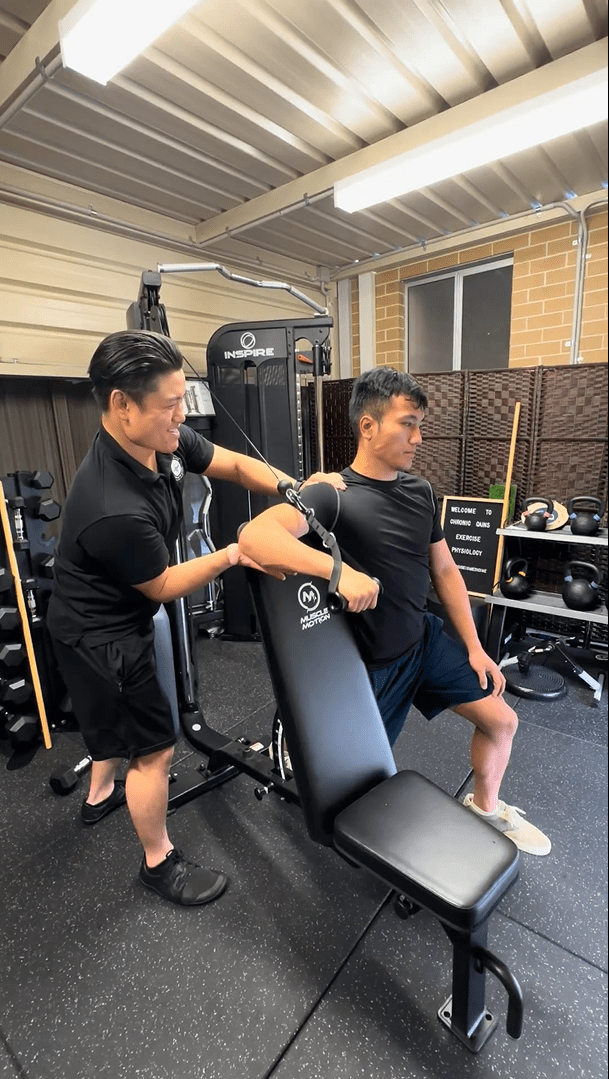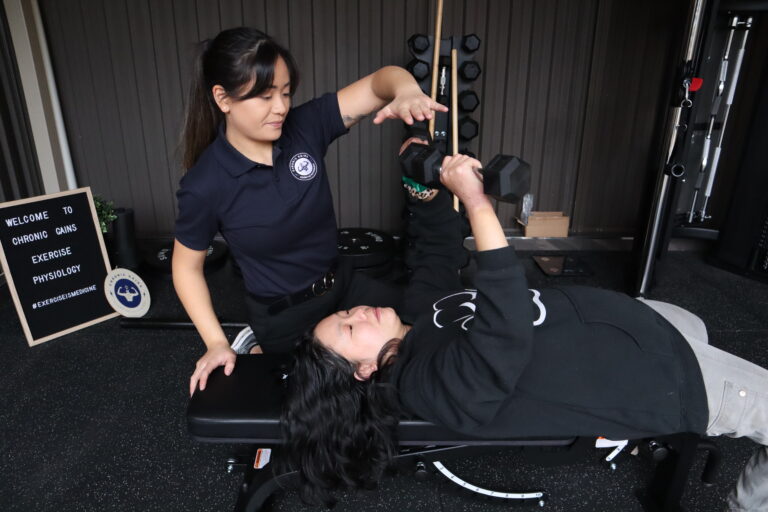Early Referral to Exercise Physiology: The Key to Quicker Recovery for Workers Compensation Clients
Delays in recovery. Spiralling claim costs. Workers disengaged from their roles and identities. This is the reality for many people injured at work, and for the teams managing their rehabilitation.
But what if there was a clear, research-supported strategy that improves recovery speed, reduces treatment costs, and helps injured workers return to meaningful work earlier?
There is. It’s called early referral to an Accredited Exercise Physiologist (AEP).
At Chronic Gains, we work closely with NDIS participants, CDM (Chronic Disease Management) referrals, workers compensation clients, CTP (Compulsory Third Party) claims, DVA (Department of Veterans’ Affairs) clients, and private patients across Sydney and Bankstown, delivering evidence-based movement rehabilitation that changes lives. Whether someone is recovering from a work injury, managing a chronic condition, or rehabilitating post-accident, our early and tailored approach helps them reclaim strength, independence, and control.
A Brief Look at the Role of Exercise Physiologists

Accredited Exercise Physiologists (AEPs) are allied health professionals trained to deliver safe and effective exercise interventions for clients dealing with injury, chronic conditions, or physical limitations. They are qualified under national standards set by ESSA (Exercise & Sports Science Australia) and recognised within the SIRA workers compensation scheme as key providers in rehabilitation and return-to-work.
In a workers compensation setting, AEPs focus on:
- Assessing functional limitations and job demands to understand capacity gaps
- Prescribing structured, goal-driven exercise plans based on real work tasks
- Delivering active, evidence-based treatment rather than relying solely on passive care
- Preventing re-injury through education and long-term self-management strategies
- Working collaboratively with doctors, case managers, employers, and rehabilitation providers
According to the ACSM Guidelines for Exercise Testing and Prescription, structured physical activity promotes physiological recovery, mental resilience, and the restoration of everyday function. Early referral ensures these benefits are harnessed before complications arise.
Why Early Referral Matters
Timing is one of the most critical factors in successful rehabilitation. The earlier an injured worker is referred to an Accredited Exercise Physiologist (AEP), the better the chance of restoring function, preventing chronic issues, and facilitating a safe return to work.
According to the State Insurance Regulatory Authority (SIRA), delays in initiating rehabilitation are closely associated with:
- Increased likelihood of long-term disability: When physical conditioning deteriorates and confidence is lost, it becomes harder for workers to return to their previous roles. Prolonged inactivity can result in irreversible loss of function, particularly in older adults or those with existing health conditions.
- Higher risk of chronic pain development: Delayed movement can shift an acute injury into a chronic pain condition. Without early intervention, the nervous system may begin to interpret non-harmful activity as painful, creating a pain loop that’s harder to treat.
- Extended time away from work: The longer someone is out of work, the less likely they are to return. In fact, studies show that after 12 weeks off, the chance of a worker returning to their pre-injury role drops significantly. Early EP referral helps maintain capacity and engagement.
- Greater mental health decline and disengagement from recovery: Isolation, loss of income, fear of movement, and frustration with slow progress can all contribute to anxiety or depression. When clients feel disempowered, they disengage from therapy — making recovery even harder. Early, supportive rehab re-establishes hope and structure.
Moving from Passive to Active Treatment
Traditional recovery pathways often over-rely on passive treatments: medication, rest, or waiting for imaging and reviews. However, these approaches can inadvertently reinforce inactivity and fear-avoidance. Early referral to an EP introduces active recovery, grounded in movement and goal-directed exercise, which research consistently shows to be more effective for work-related injuries.
ESSA and ACSM both advocate for early functional exercise to:
- Maintain muscle mass, mobility, and cardiovascular fitness
- Reduce inflammation and stiffness through controlled movement
- Support mental health by fostering routine, autonomy, and purpose
- Encourage belief in recovery and physical capability
Real Scenario:
A 43-year-old retail worker in Bankstown experiences a rotator cuff injury from repetitive overhead tasks. Referred to an EP within two weeks, she begins structured shoulder mobility and strength work, aligned with her job demands. By week 5, she returns to modified duties and regains full work capacity by week 9 — avoiding prolonged time off and reducing risk of re-injury.
Compare this to a client referred after 10 weeks: they often require double the rehab time due to muscle atrophy, fear, and poor conditioning. Early movement, guided by an EP, makes all the difference.
Benefits of Early EP Referral:
- Interrupts the injury-pain-disability cycle before it becomes entrenched
- Keeps clients connected to goals and routines
- Reduces claim costs through faster functional gains
- Supports team-based planning with early functional assessments and capacity reports
Early action builds momentum. It replaces uncertainty with progress and positions the worker — not the injury — at the centre of the recovery journey.
EPs Improve Return to Work Outcomes
A safe and sustainable return to work is the ultimate goal of any injury rehabilitation plan. But returning to work isn’t just about clocking in — it’s about having the physical capacity, confidence, and resilience to meet job demands safely.
Accredited Exercise Physiologists (AEPs) are uniquely positioned to make that happen by delivering tailored, task-specific rehabilitation that prepares workers for real-world performance — not just clinical recovery.
Why EPs Are Essential to RTW Success
Unlike general practitioners or passive therapy providers, EPs take a functional, movement-based approach. They build strength, restore capacity, and simulate workplace tasks in a controlled, progressive way.
At Chronic Gains, we align every treatment plan with the worker’s actual role, making return-to-work not just possible — but practical and sustainable.
Here’s how we do it:
- Work-specific conditioning: Exercises are tailored to match the physical demands of the worker’s job — from lifting and bending to standing, reaching, or desk work.
- Graded exposure to tasks: We simulate work environments, gradually rebuilding the client’s tolerance to the movements and tasks they’ll face on the job.
- Pain education and movement re-training: EPs help clients understand the difference between discomfort and danger, and guide them back into motion safely.
- Collaborative planning: We liaise with employers, case managers, doctors, and rehab providers to align treatment goals with return-to-work milestones.
- SIRA-compliant capacity documentation: Our reports support decisions around modified duties, capacity upgrades, and treatment extensions.
Real Case Example
- Client Profile: 32-year-old warehouse worker with low back strain
- Early Referral: Referred to Chronic Gains EP at Week 2 post-injury
- Program: Functional lifting, core stability, crate and pallet simulation
- Outcome: Returned to modified duties by Week 6, full duties by Week 9
- Claim Duration: <10 weeks
- Delayed Referral Comparison: Same job and injury, but referred at Week 10
- Challenges: Severe deconditioning, pain avoidance, low confidence
- Outcome: Full RTW at Week 20 — claim cost more than doubled
The difference? Timing, movement, and a job-matched rehab plan.
EP Focus by Job Role
| Job Role | Injury Risks / Challenges | EP Rehabilitation Focus |
|---|---|---|
| Aged Care Worker | Lower back strain, manual handling injuries | Safe lifting, patient transfers, lumbar strength, work shift endurance |
| Retail Staff | Shoulder overuse, fatigue, poor posture | Overhead mobility, core control, postural stability, ergonomic setup |
| Construction Worker | Load stress, ladder work, repetitive strain | Load tolerance, joint protection, stability, work simulation |
| Office Admin | Neck/back tension, postural overload | Desk ergonomics, thoracic mobility, active posture breaks |
| Delivery Driver | Hip stiffness, prolonged sitting, step mechanics | Seated posture control, vehicle entry/exit simulation, core strength |
| Hospitality Staff | Lower limb strain, fatigue, slippery environments | Lower limb strength, balance training, shift pacing strategies |
| Healthcare Worker | Manual handling, shift fatigue, shoulder strain | Transfer training, upper limb coordination, shift tolerance |
Quick FAQ for Referrers
Q1. When should I refer to an EP?
→ Ideally within the first 1–3 weeks post-injury. Early movement preserves capacity and builds rehab momentum.
Q2. What does EP rehab involve?
→ Functional assessment, personalised exercise prescription, job simulation, and progress reporting aligned with SIRA standards.
Q3. Can EPs help coordinate return-to-work?
→ Yes. EPs work closely with employers and rehab providers to structure safe and progressive duties.
Benefits For Workers
Injured workers often face not just physical limitations but emotional and psychological challenges. Early engagement with an EP empowers them to rebuild both capacity and confidence.
Benefits include:
- Quicker return to daily life, work, and activity
- Reduced reliance on medication or passive care
- Improved mental health through structure and self-efficacy
- Lower risk of long-term disability or re-injury
- Education for long-term movement safety and independence
Benefits For Case Managers & Insurers
Efficient referrals translate into smoother claims, lower costs, and better outcomes.
Key outcomes include:
- Reduced treatment duration and overall claim costs
- Fewer extensions or unnecessary approvals
- Improved compliance with SIRA’s Allied Health Framework
- Stronger documentation for liability and decision-making
- More engaged and satisfied claimants
Benefits For Employers
Delayed recovery can disrupt workforce capacity and morale. Employers who support early rehabilitation see measurable returns.
Key employer wins:
- Earlier return of experienced workers
- Reduced need for temporary staffing and overtime
- Support for WHS and injury management compliance
- Documented rehab engagement for audits and premiums
- Increased confidence in future injury handling
Benefits For the Health System
The downstream benefits of early EP intervention reduce pressure on hospitals, specialists, and long-term services.
System-wide benefits:
- Reduced imaging, surgical referrals, and pain clinic demand
- Promotion of preventative care through education and movement
- Fewer chronic pain presentations
- Improved alignment with public health policies from NSW Health and ACSM
Outcome Snapshot: Early vs Delayed EP Referral
| Outcome Measure | Early EP Referral (< 3 weeks) | Delayed EP Referral (> 8 weeks) |
|---|---|---|
| Claim Duration | 6–12 weeks | 18–24+ weeks |
| Return to Work Rate | 85–95% | 50–70% |
| Re-injury Risk | Low (5–10%) | Moderate to High (20–30%) |
| Total Treatment Sessions | 8–12 (avg) | 20–30+ (avg) |
| Psychosocial Risk | Low | Elevated |
| Claim Cost (Est. Avg)* | $4,500–$6,500 AUD | $12,000–$18,000 AUD |
*Based on SIRA data and industry norms. May vary by injury, employer size, and case complexity.
Cost Impact Summary
On top of impacting outcomes, delaying EP referral also directly inflates claim costs. On average, claims involving early EP involvement cost 40–60% less than those with delayed rehab or reliance on passive care alone.
For insurers and employers, that means:
- Fewer lost work hours
- Reduced premium pressures
- Better budgeting and resource planning
Investing in early movement leads to earlier discharge — and better return on every rehab dollar spent.
Ready to Refer or Learn More?
✅ Explore Our Services — From work injury rehab to chronic disease management
✅ See Our Treatments — Designed for real-world return to function
✅ View Testimonials — Hear how we’ve helped others
✅ Check Funding Options — Including Medicare, DVA, NDIS, SIRA, and more
✅ Meet the Team — Learn our story and values
✅ Contact Us — Make a referral or speak to our team today
Let’s work together to help your clients move better, recover faster, and return to life — stronger, sooner, and supported every step of the way.







